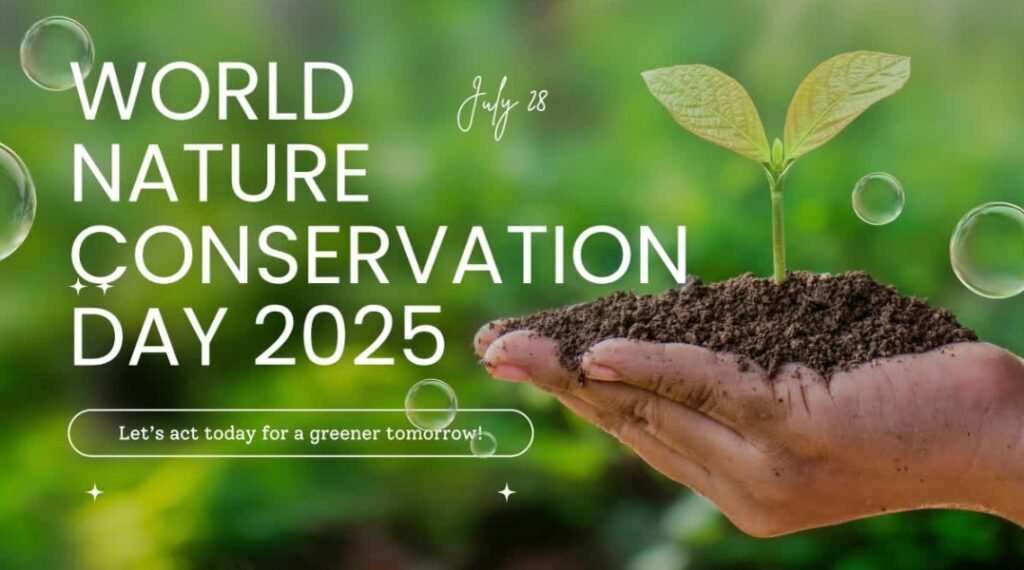
When was the last moment you truly noticed nature around you? Maybe it was seeing a sparrow where you least expected or simply noticing the monsoon rains arrive in your city. World Nature Conservation Day 2025 finds India at a critical turning point, caught between extraordinary natural wealth and mounting environmental pressures. The theme, “Connecting People and Plants: Exploring Digital Innovation in Wildlife Conservation,” is a call to rethink our relationship with nature as well as the ways we protect it. Conservation in India is no longer just official strategy—it’s now influenced by everything from grassroots efforts to the latest digital developments. By looking at our collective journey and the innovations powering it, we understand how individual actions and national initiatives together move us towards a healthier, more sustainable environment.
Bridging Tradition and Technology: The 2025 Conservation Theme
Traditional connections with nature in India have always been deeply rooted. Our grandparents once passed down stories and rituals that honored forests and rivers, creating a culture where nature was respected and protected at a local level. Today, the world has changed rapidly, and technology is being woven seamlessly into the conservation tapestry. Digital mapping by local groups, wildlife tracking with mobile apps, and the monitoring of forests with drones have all become key elements of strategy nationwide.
The ability to connect people and plants through digital means, as highlighted in this year’s World Nature Conservation Day theme, brings benefits previously unimaginable. Now, a farmer in Assam can contribute data on local biodiversity, while a student in Mumbai uses social media to organize a tree-planting drive. With digital innovation in conservation, everyone—regardless of geography or background—can play a meaningful part. This shift is helping to democratize conservation and deliver more responsive and practical solutions than ever before.
Ancient Roots: Our Green Heritage Isn’t Just a Legend
India’s relationship with nature is centuries old. Sacred groves are often guarded by entire communities, and temple tanks quietly support both wildlife and people. This depth of reverence is echoed in ancient texts and enduring traditions, which laid the groundwork for modern conservation philosophies. The Chipko Movement of the 1970s—where villagers embraced trees to prevent their felling—embodied the merging of cultural values and ecological awareness. As Sunderlal Bahuguna emphasized, “The Chipko movement taught us, and the world, that hugging a tree is sometimes the boldest act of resistance.” His conviction resonates in environmental campaigns to this day.
This history strongly influences our approach on World Nature Conservation Day. These traditions are not mere relics; they actively inspire modern conservation laws, policies, and social awareness campaigns. By blending ancient respect with contemporary science, we protect and cherish our environment more effectively than before. Standing at this crossroad, we unite old wisdom with new strategies, forming a resilient and adaptive stewardship. This fusion shapes India’s conservation values today, urging us to act with reverence and responsibility.
Policy Leaps: Every Milestone Tells a Story
India’s progress in conservation is shaped by a series of landmark decisions. The Wildlife Protection Act of 1972 marked a foundational change in the way we approached nature. The launch of Project Tiger in 1973 elevated India’s role on the global stage, ensuring over 70% of the world’s wild tigers persist within our borders. Over the years, the focus expanded to include elephants, rhinos, and community reserves, emphasizing both species protection and ecosystem resilience. Between 2014 and 2025, the number of protected areas grew from 745 to 1,022, now covering over 5% of Indian territory.
Yet conservation is more than regulation and reserve boundaries. True achievement is reflected in the revival of grasslands, the return of threatened wildlife, and communities actively caring for their local environment. This World Nature Conservation Day, each milestone shows that a robust framework, when coupled with community involvement, makes it possible to balance development and preservation effectively.
India’s Conservation Milestones
| Year | Policy/Initiative | Result |
|---|---|---|
| 1972 | Wildlife Protection Act | Launched modern wildlife protection |
| 1973 | Project Tiger | 57 reserves; 70% world tiger population in India |
| 1992 | Project Elephant | 33 elephant reserves: pioneering coexistence |
| 2014–25 | Expansion of protected areas | 1,022 reserves, covering 5.43% of India |
| 2022 | Kunming-Montreal Biodiversity Framework | 30% degraded land to be restored by 2030 |
| 2025 | “Ek Ped Maa Ke Naam” | 140 crore trees planted; massive citizen involvement |
Source: MoEFCC reports, 2025
Biodiversity Conservation India: Our Wild Fortune (And Its Fragility)
India holds a unique position as a biodiversity powerhouse, sustaining 8% of the world’s species on just 2.4% of land. Our hotspots—the Western Ghats, Himalayas, Northeast, and Andaman & Nicobar Islands—are crucial for securing food, medicinal resources, and climate resilience. A drop in just one species can have ripple effects, threatening not just nature but also the stability of agriculture and healthcare.
The crisis remains urgent, as 22% of Indian vertebrate species are vulnerable and roughly 40% of India’s land faces restoration needs. Biodiversity conservation in India is essential, not just desirable. Prime Minister Narendra Modi summed it up aptly, “Every species plays a vital role—let’s safeguard their future for generations to come… India takes pride in its contributions towards preserving and protecting wildlife.” On World Nature Conservation Day, our challenge now is to turn this pride into a practical, ongoing practice of protection.
India’s Biodiversity in 2025
| Metric | Status (2025) |
|---|---|
| Global land share | 2.4% |
| World biodiversity share | 7–8% |
| Hotspots | 4 |
| Flowering plant species | 17,527 |
| Animal species | >91,000 |
| Threatened vertebrates | 22% |
| To-be-restored degraded land | 30% by 2030 |
Source: National Biodiversity Authority, 2025
Today’s Challenges: The Ongoing Battle
Environmental threats in India are complex and often interlinked. Air pollution remains a leading health hazard, claiming over a million lives a year, while droughts, floods, and water stress disrupt communities across the country. Twelve of the world’s fifteen most polluted cities are right here in India, underlining the urgency of meaningful action. Despite these daunting statistics, there is a collective determination to forge solutions.
Initiatives like the revised Green India Mission have shifted the focus from mere tree planting to ecosystem restoration. Urban wetland projects, stronger plastic bans, and new resource management rules are empowering local leaders. Environmental issues, as Sunita Narain notes, “are not just about birds and tigers—they’re about us, about justice, about the right to life itself.” Addressing these challenges requires a combination of modern solutions and time-tested values.
Digital Innovation in Conservation: The Game-Changer We Need
Modern technology is redefining conservation across India on World Nature Conservation Day. Drones now supplement ground patrols in forests, AI software helps quickly identify poaching threats, and satellites reveal illegal land use in real time. Villagers armed with smartphones contribute crucial sightings via geotagged photos, turning citizen science into a national resource.
This digital innovation in conservation delivers sharper monitoring and faster response, connecting urban and rural communities. As information becomes easier to collect and act upon, everyone from forest guards to school children plays a genuine part. Conservationist Ipra Mekola observes, “What is the point of all the development if it comes at the cost of clearing forests and driving wildlife species into extinction? I hope more people are inspired to step up and fight for the environment before it’s too late – starting from their own locale.” These insights remind us that technology is an enabler, not a replacement, for genuine stewardship.
The Power of People: When Villagers Lead, Nature Wins
On this World Nature Conservation Day, grassroots participation is at the heart of successful conservation in India. Across the Northeast, students catalog endangered frogs, while elders pass down the secrets of sacred groves. The number of community reserves has grown fivefold in a decade, demonstrating the strength of local action when trusted and empowered. These reserves often protect fragile ecosystems overlooked by larger government programs. This growing movement highlights how conservation rooted in local knowledge and sustained community effort creates places of refuge for threatened species.
Government campaigns such as “LiFE” (Lifestyle for Environment) encourage practical, everyday behavioral changes—refusing single-use plastic, nurturing a wetland, or planting a native sapling. Engagement at the local level transforms environmentalism from abstract concern into daily practice, ensuring that conservation is not just about policies but lived values shared across generations. When communities see tangible benefits—be it cleaner water, healthier soil, or sustainable livelihoods—their motivation and commitment multiply. This people-powered model makes conservation inclusive and enduring, blending tradition with modern environmental goals and fostering a shared sense of responsibility for our natural heritage.
Records Galore: Real Progress and Fresh Challenges
On July 9, 2025, Uttar Pradesh planted an unprecedented 37.21 crore (372 million) saplings in a single day across the state, showcasing the tremendous power of coordinated citizen action. In the Prayagraj division alone, over 2.08 crore saplings were planted in one day, exceeding its official target. The largest one-day tree plantation record in India—and believed globally—was Uttar Pradesh planting nearly 50 million trees in a single day in 2016, part of a climate action drive. In July 2024, the city of Indore planted about 11 lakh (~1.1 million) saplings in a single day, setting a Guinness World Record for a single city. Sustainable tree planting not only restores degraded landscapes but also enhances soil health, boosts biodiversity, and empowers local communities to build resilient ecosystems for generations to come.
The Supreme Court has recently expanded “no-development” buffer zones in fragile Himalayan areas, responding decisively to the devastating landslides that threatened both lives and ecosystems. This judicial intervention highlights how legal frameworks can adapt to emerging environmental crises, ensuring vulnerable habitats receive effective protection. Meanwhile, states such as Maharashtra and Kerala have introduced public fines for plastic dumping into rivers, turning pollution from a silent problem into a punishable offense. This new wave of accountability has begun shifting community. On World Nature Conservation Day, these developments illustrate how India’s conservation efforts are marked by both inspiring achievements and ongoing challenges requiring vigilant attention.
Holistic Changes: The Road Ahead for India
To secure India’s ecological future, changes must be both deep and wide-ranging. Stronger enforcement of environmental laws, coupled with genuine penalties for violations, is essential. Economic incentives and sustainable livelihood options need to flow to communities most responsible for conservation. Strategic investment in digital innovation in conservation will empower both citizens and frontline workers and bring greater efficiency to monitoring and management.
India must also promote waste as a resource, expand the circular economy, and actively restore degraded ecosystems. Most importantly, youth and traditionally marginalized voices should have access to platforms and funding to ensure biodiversity conservation India remains robust. This comprehensive, inclusive approach is what World Nature Conservation Day now stands for—a living challenge and an opportunity for all.
World Nature Conservation Day should not remain a simple date or social media trend—it must inspire lasting commitment. Our forests, rivers, and wildlife need your attention, your advocacy, and your practical support, whether by planting a tree, modelling sustainable habits, or urging better policy from leaders. Each action, big or small, contributes to the overall strength of India’s conservation journey.
India’s natural wealth and resilience depend on individuals, communities, and systems working together. If not us, who? If not now, when?
#WorldNatureConservationDay #DigitalInnovationInConservation #BiodiversityConservationIndia #NatureConservationIndia
